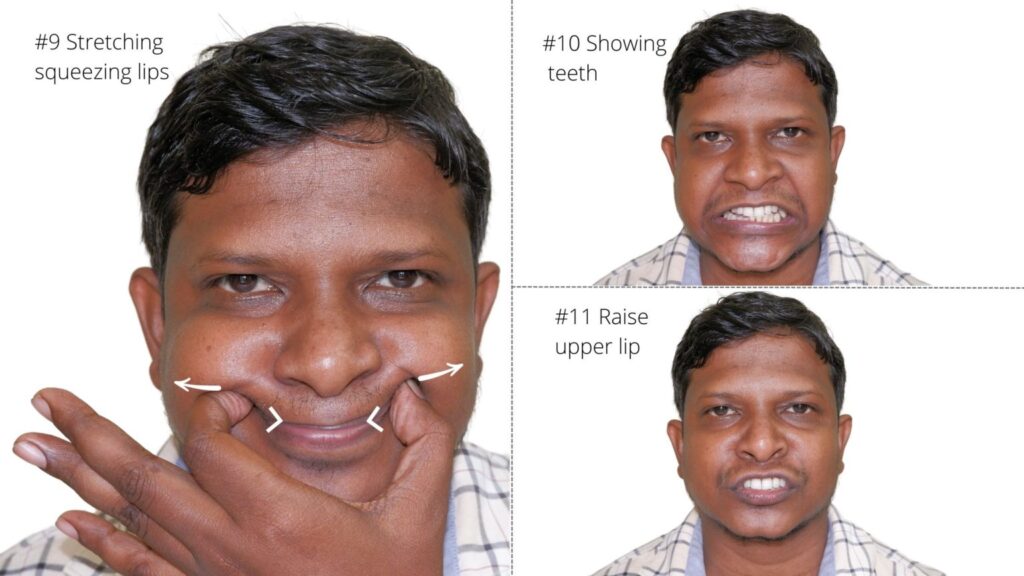Last updated on July 3rd, 2025 at 05:05 pm

Scapular winging (or ‘winging of the scapula’) is a condition where your shoulder blade protrudes abnormally, causing pain and limiting arm movement. Often caused by nerve damage or weak serratus anterior muscles, it can make daily tasks like lifting groceries or brushing hair difficult1.
The good news? Targeted exercises can help. In this guide, you’ll learn 6 simple, evidence-backed exercises to correct scapular winging at home—complete with step-by-step videos and tips from physiotherapists.
Key Takeaways: 6 Best Exercises for Winging of Scapula
- Wall Pushups – Like regular pushups’ easier cousin. Perfect if you’re just starting out!
- Shoulder Blade Squeezes – Pretend you’re holding a pencil between your shoulder blades (works wonders for posture!).
- Band Pull-Aparts – Grab a resistance band and give those shoulder muscles some love.
- Boxer Punches – Not for fighting – for fixing! Strengthens that sneaky serratus muscle.
- Military Pushups – Level up when you’re ready for a real challenge.
- Trapezius Toners – Four ways to hit all angles of those upper back muscles.
- How to Fix Winging of Scapula: 6 Proven Exercises
- 1: How to Do Wall Pushups for Scapular Stability (Step-by-Step)
- 2: Scapular Retraction: Strengthen Your Shoulder Blades in 5 Simple Steps
- 3: Resistance Band Scapular Retraction: Boost Muscle Activation Fast
- 4: Serratus Anterior Punch: Fix Winged Scapula with This Powerful Move
- 5: Military Push-Ups: Advanced Scapular Strengthening (Proper Form Guide)
- 6: Trapezius Strengthening: 4 Key Movements to Stabilize Your Scapula
- Other Treatment Options for Scapular Winging: When to Seek Help
How to Fix Winging of Scapula: 6 Proven Exercises
To understand these exercises, you must first understand what the winging of scapula is and why it occurs. Our upper back has shoulder blades known as the scapula bones.
In normal conditions, this bone remains close to our back by the action of muscles around the shoulder blade.
But if there is weakness or paralysis of these muscles, they become incapable of holding them in place, and the medial part of the bone protrudes away from the body. From the outside, it appears to be the spreading of wings; thus, it is called the winging of scapula.
Because of this, the sufferer cannot push, pull or lift heavy objects, and it doesn’t look good cosmetically as well as the bone on one side is protruding.
The exercises that I am going to discuss are those that strengthen the muscles around our scapula at the upper back. So, let us start with wall push-ups.
1: How to Do Wall Pushups for Scapular Stability (Step-by-Step)
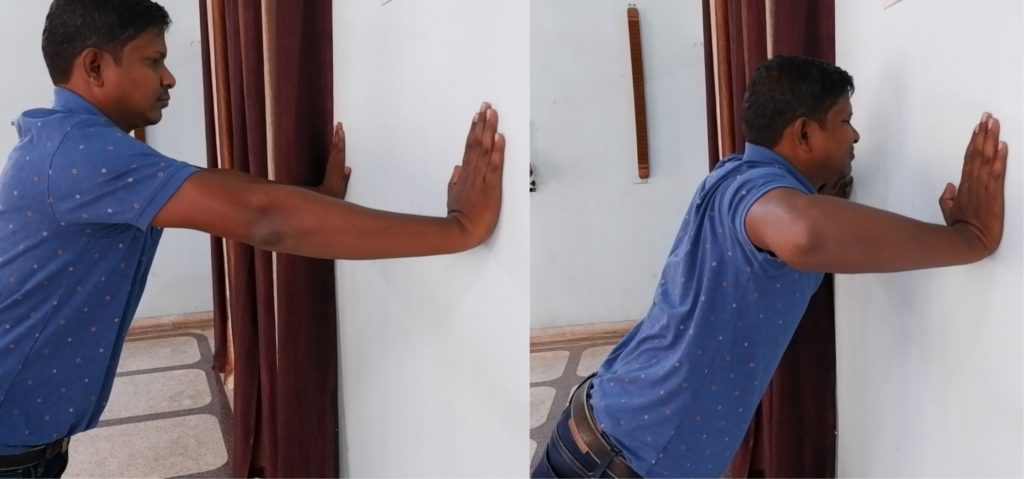
So, the first exercise on the list of 6 easy exercises for winging the scapula is the Wall Push. Unlike regular military pushups, which we will cover later in this article, are performed in a standing position.
Here’s a step-by-step process to perform this accurately and effectively.
- First, stand in front of a wall facing it and at a distance of arm’s length.
- Now, place your hands on the wall, slightly wider than shoulder-width apart and at a level of shoulder height. Keep your arms straight and engage your core to make yourself stable.
- In this position, lean forward slowly and smoothly towards the wall, bending your elbows and lowering your body towards the wall. One thing you have to ensure while leaning yourself forward is to keep your body straight and your feet firmly on the ground.
- Hold your chest as close to the wall as possible, hold this position for 5 seconds, and then push yourself back away. Push yourself by straightening your arms and coming back to the initial starting position.
- While doing this, you should keep breathing throughout the exercise; the best way is to inhale when lowering yourself down and exhale as you push yourself away from the wall.
- Do these push-ups for a minimum of 15-20 repetitions; the more you do, the better it is.
2: Scapular Retraction: Strengthen Your Shoulder Blades in 5 Simple Steps
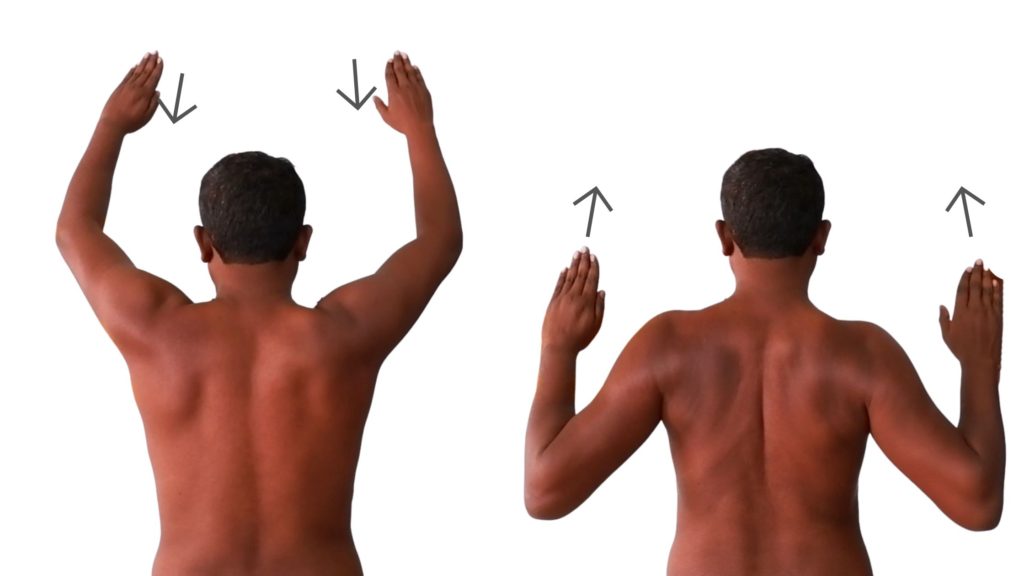
The next exercise is called Scapular Retraction. Retraction means pulling or retracting the shoulder blade (scapula) behind.
This exercise effectively strengthens the muscles around the shoulder blade and controls the shoulder blade bones. This exercise is also very simple.
- Your starting position for this should be standing straight. In this position, elevate both arms so that the finger should point to the roof.
- Lower your arms to squeeze your shoulder blades together and down your back. This is the movement you want to emphasize in this exercise.
- Hold this position for 5 seconds, then raise your arms again.
- Do a minimum of 15-20 repetitions of this exercise; the more, the better.
This will slowly strengthen the muscles of the scapula behind.
3: Resistance Band Scapular Retraction: Boost Muscle Activation Fast
Alternatively, a resistance band can also perform this scapular retraction exercise. This becomes our third exercise on the list of exercises for winging the scapula.
For this, you need a resistance band, a band made of latex-free rubber that can be used to perform various other exercises, such as exercises for the shoulder using a resistance band or knee exercises.
This exercise can be performed in a sitting or standing position; however, we recommend it be done in a standing position.
- So, first, anchor the resistance band to a secure object at the chest height level.
- Hold the band’s two ends with your hands and stand facing the anchor point.
- It would help if you kept your arms fully straight in front of you and then pull the band towards your chest.
- Pull it against the band’s resistance and squeeze your shoulder blades together.
- Hold this position for 5 seconds, then release it.
- Repeat the exercise at least 15-20 times in a session.
Pro Tip: Once you’ve mastered basic scapular retractions, try these 17 advanced shoulder band exercises to build full upper-body stability.
4: Serratus Anterior Punch: Fix Winged Scapula with This Powerful Move
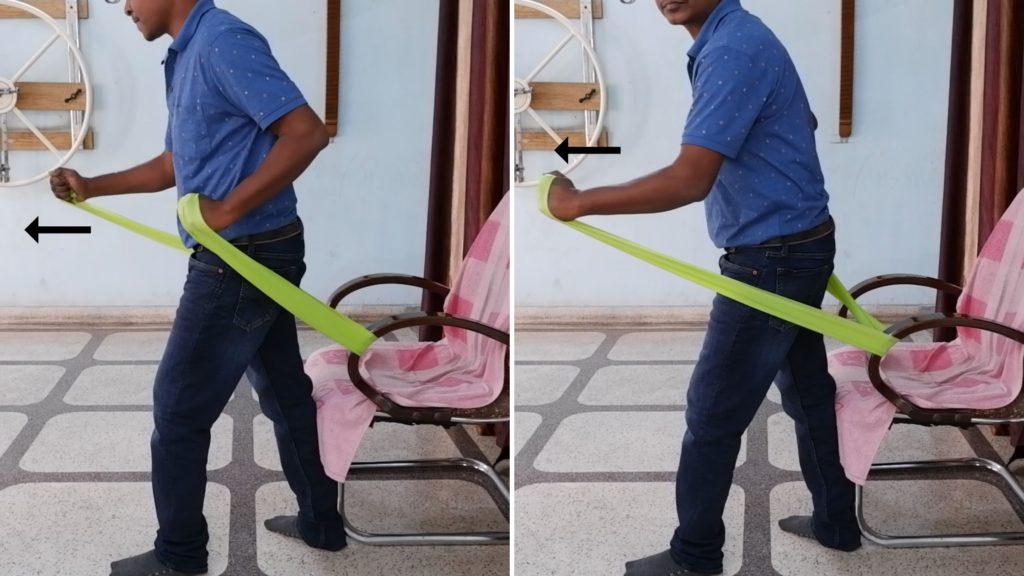
Our next shoulder blade winging exercise is called the serratus anterior punch. In this exercise, we will be performing using a resistance band. It is termed a serratus anterior punch as it helps strengthen the serratus anterior muscle.
Once you have mastered these exercises, you progress with more sophisticated shoulder exercises using a thera band or resistance band.
The serratus anterior muscle is a large muscle located on the side of the chest. It helps protract or move the shoulder blade forward, away from the spine, which is essential for many activities such as pushing, punching, and throwing.
- So, to perform the serratus anterior punch first, you need to anchor the resistance band to a sturdy object, such as a door handle or a post. Make sure that the anchor point is at about chest height.
- Now, stand so that the anchor remains on your backside and hold the two ends of the resistance band with two hands. Position your arms as if you will punch someone before you.
- Keep your arm by your side, your elbow bent to 90 degrees, and your forearm parallel to the ground. Hold the band in a stretched position.
- In this position, punch forward one hand against the band’s resistance as if punching an imaginary target. After this, let this hand return to its normal position by slowly releasing the tension in the band.
- Now, it’s time to punch the other side’s hand and follow the same rule.
- Repeat the exercise for a minimum of 15-20 repetitions this exercise, the better.
For best results, use a latex-free resistance band like the TheraBand Set (5 resistance levels). The medium (red) band is ideal for beginners.
- A superior band product for resistance training and rehabilitation, provides both positive and negative force on muscles…
- Simple & easy to use product for upper & lower body exercises that can be performed anywhere, is ideal for conditioning …
- Color-coded Progressive Resistance system allows users to recognize improvement as it happens, as you grow stronger you …

5: Military Push-Ups: Advanced Scapular Strengthening (Proper Form Guide)
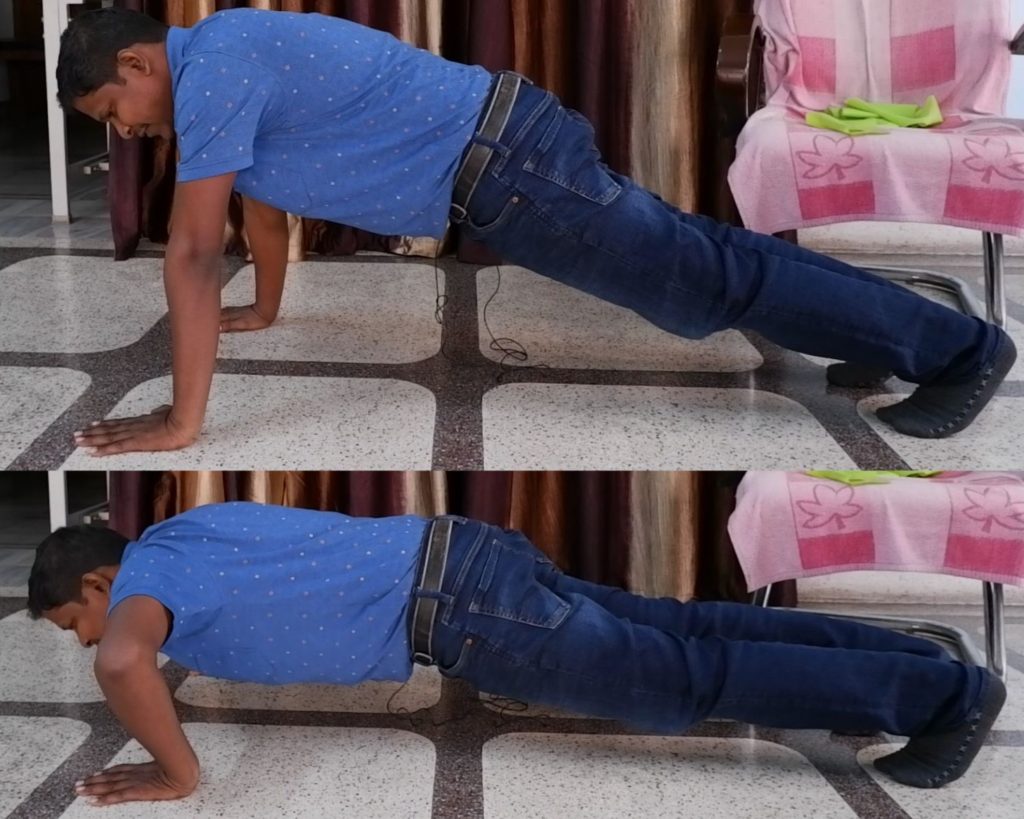
The following exercise is called simple military push-ups; you may know it. This exercise is performed in a high plank position with your hands shoulder-width apart and directly under your shoulders.
Your foot should be kept together, and your leg should be supported over the ball of your toes. Try keeping your body straight from your head to your heels, keeping the lower back flat by contracting the core muscle.
Now, slowly and smoothly lower your body towards the ground by bending your elbows and keeping them close to your body. Try to keep your body in a straight line and lower yourself until your chest nearly touches the ground.
Hold this position for 5 seconds, then push yourself back up to the starting position by straightening your arms. Repeat the movement for at least ten repetitions of this exercise.
6: Trapezius Strengthening: 4 Key Movements to Stabilize Your Scapula
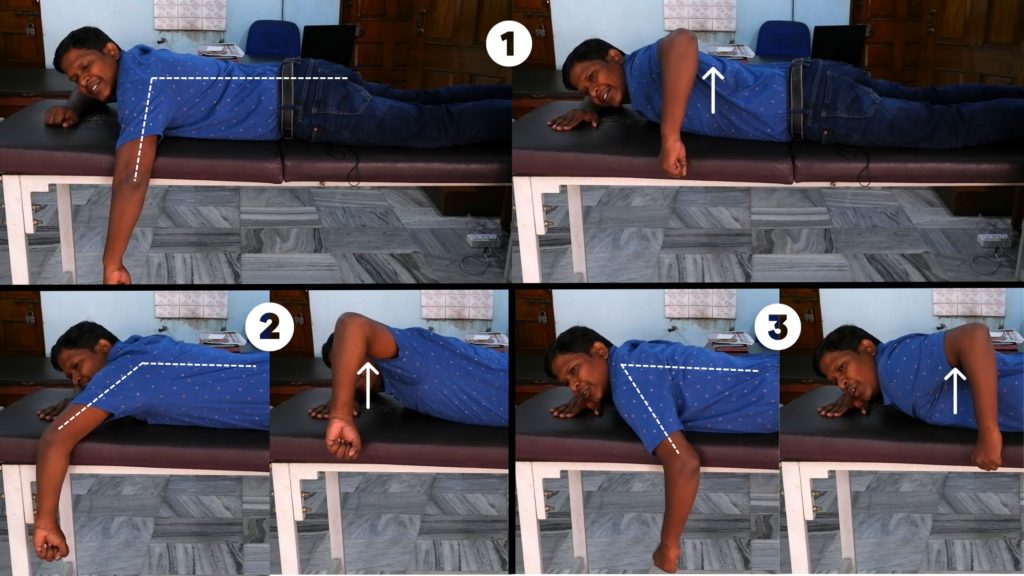
Trapezius muscles are a group of muscles on our upper back around the shoulder blade.
- So, for this exercise, lie down on your tummy on a high bed and keep the affected side arm straight out to the side, parallel to the floor, with your forearm hanging by the side.
- Now, smoothly lift your arm off the bed and squeeze the shoulder behind. Hold this position for 5 seconds, then lower your arm to the bed. Repeat this ten times.
- After this, we need to change the arm’s position, take it closer to the head, and keep the arm diagonally upward. Now, repeat the same process of lifting the arm. Do this ten times in this position.
- Next, take your arm downward diagonally and close the trunk. In this position, repeat the exercise 10 times.
Keep your core engaged and your hips and legs relaxed during the exercise. Keep your breathing regular, exhale as you lift your arm off the bed, and lower it back down.
You can progress with the exercises by adding weight or resistance. This can be done by adding resistance by holding light weights or bands.
Other Treatment Options for Scapular Winging: When to Seek Help
Pair exercises with posture awareness tools like the Straight Plus AI Powered Posture Corrector Trainer Device to reinforce scapular positioning throughout your day
- Smart Posture Trainer with BioFeedback Technology: Kodgem Straight Plus helps improve posture using BioFeedback technolo…
- Lightweight and Invisible Design for Daily Use: Lightweight and discreet, Straight Plus fits seamlessly under your cloth…
- Real-Time Tracking with Mobile App Integration: Straight Plus connects to a user-friendly mobile app that tracks your po…

Often, the cause of winged scapula is neurogenic, i.e. due to damage to the long nerve supplying the muscle around the shoulder blade.
In the case of injury to a long thoracic nerve, one of the studies has demonstrated the beneficial effect of using a scapular-protecting brace2. You may consider progressing with other shoulder exercises to fix residual pain and stiffness as the condition improves.
For patients with limited mobility, passive tools like shoulder wand exercises can help restore range of motion before strengthening.
You may need surgical intervention if you don’t benefit from the exercises or the brace. Depending on the cause and degree of winging, various surgical treatments are available, including wire fixation, muscle transfer, and nerve grafts3.
It is beyond the scope of this article to discuss this surgical procedure in detail. However, if you have been advised to go with conservative management, the above exercises will help you.
Important: If you’ve had previous shoulder injuries, these 17 dislocation prevention exercises should be part of your rehab plan to avoid complications.
Keep Reading: How Do I Stop My Shoulder From Hurting When I Sleep?
FAQ on scapula alata
The author is a physiotherapist who has been practising for the last 17 years. He holds a Bachelor's in Physiotherapy (BPT) from SVNIRTAR (Swami Vivekananda National Institute of Rehabilitation and Research), one of the prestigious physiotherapy schools in India.
Whatever he learns dealing with his patient, he shares it with the world through blogs and e-books. He also owns a YouTube channel, "Sunit Physiotherapist" with over 8 lakh active subscribers. Here, he shares everything he gets to learn serving the patient.







